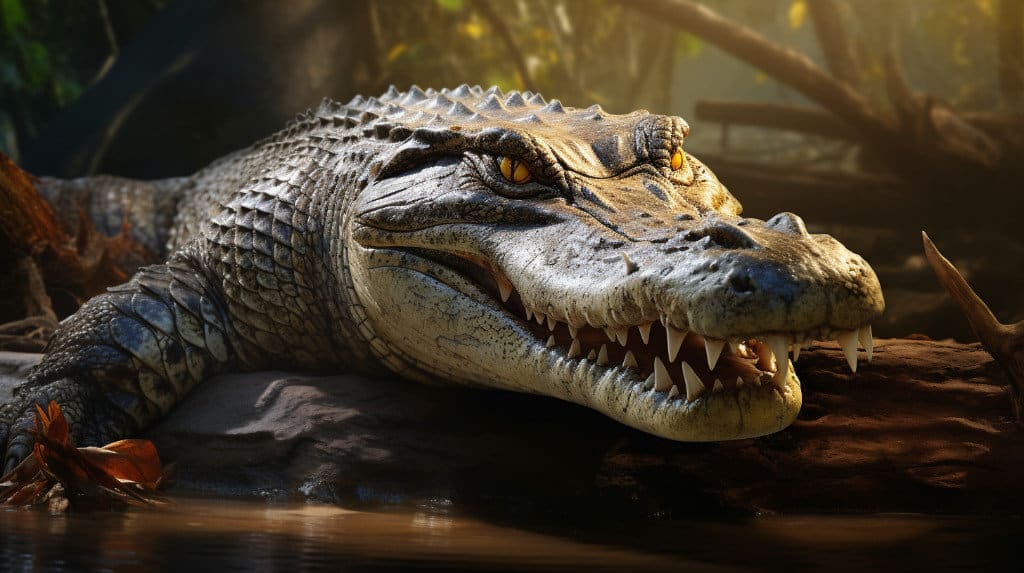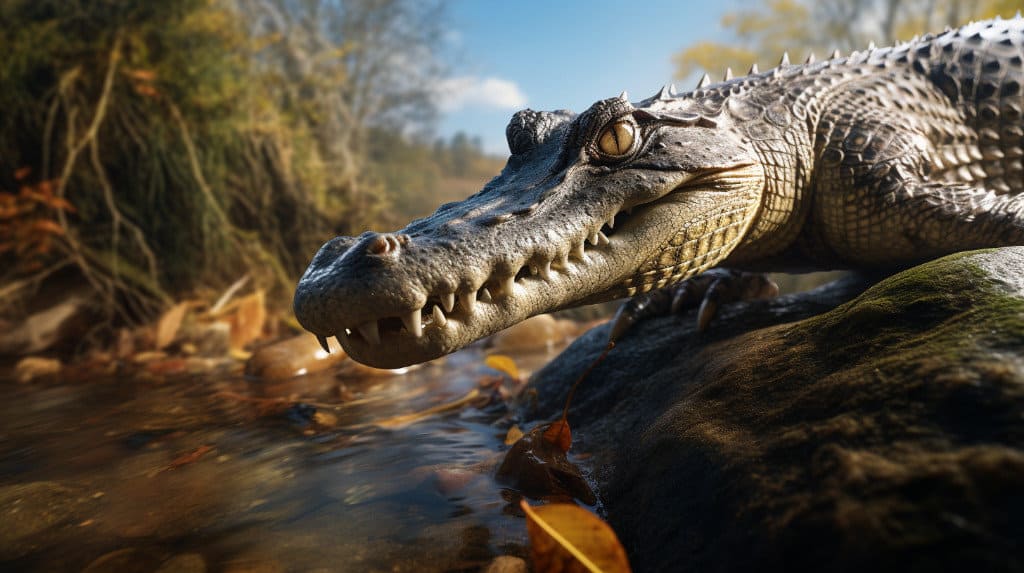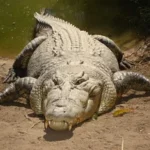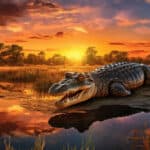Crocodiles are fascinating creatures that have been around for millions of years. They are often mistaken for amphibians due to their semi-aquatic lifestyle, but in fact, they are not amphibians. Crocodiles are reptiles and belong to the order Crocodylia. They are cold-blooded and have scaly skin, which is a characteristic of reptiles. Unlike amphibians, crocodiles do not undergo metamorphosis and do not have the ability to breathe through their skin. They are excellent swimmers and spend a significant amount of time in water, but they also come on land to bask in the sun and lay eggs. Now, let’s take a look at some key takeaways about crocodiles in the table below:
Key Takeaways
| Fact | Description |
|---|---|
| Order | Crocodylia |
| Class | Reptilia |
| Habitat | Freshwater and brackish water ecosystems |
| Diet | Carnivorous, feeding on fish, mammals, and birds |
| Lifespan | Up to 70 years |
| Size | Varies by species, ranging from 6 to 20 feet |
| Conservation Status | Varies by species, some are endangered |
Understanding Amphibians

Amphibians are fascinating creatures that inhabit both land and water. They are known for their unique ability to adapt to different environments, making them a diverse and interesting group of animals. In this article, we will explore the definition and characteristics of amphibians, as well as some common examples.
Definition and Characteristics of Amphibians
Amphibians belong to the class Amphibia, which includes frogs, toads, salamanders, and newts. One of the defining characteristics of amphibians is their dual life cycle. They start their lives in water as aquatic larvae, such as tadpoles, and then undergo metamorphosis to become terrestrial adults. This transition from water to land is a crucial part of their life cycle.
Amphibians have unique skin that sets them apart from other animals. Their skin is thin, moist, and permeable, allowing them to breathe through their skin. This adaptation is essential for their survival, as it enables them to obtain oxygen even when they are submerged in water or buried in the ground.
Another interesting characteristic of amphibians is their ability to reproduce both in water and on land. They lay eggs in water, which hatch into larvae. These larvae then undergo a series of transformations until they reach their adult form. This dual reproductive strategy allows them to take advantage of different habitats and maximize their chances of survival.
Common Examples of Amphibians
There are various types of amphibians found all over the world. Some common examples include:
-
Frogs and Toads: Frogs and toads are perhaps the most well-known amphibians. They have a unique ability to jump and are often found near bodies of water. Frogs have smooth, moist skin, while toads have rougher, drier skin.
-
Salamanders: Salamanders are characterized by their long bodies and tails. They have the ability to regenerate lost body parts, such as limbs or tails. Salamanders can be found in a variety of habitats, including forests, streams, and caves.
-
Newts: Newts are similar to salamanders but have a more aquatic lifestyle. They have a distinct flattened tail and spend a significant portion of their lives in water. Newts are known for their bright and vibrant colors, which serve as a warning to predators.
-
Caecilians: Caecilians are a lesser-known group of amphibians that resemble large earthworms or snakes. They are mostly found in tropical regions and have adapted to a burrowing lifestyle. Caecilians have no limbs and rely on their strong bodies to move through the soil.
By understanding the definition and characteristics of amphibians, we can appreciate the unique adaptations and diversity within this fascinating group of animals. From their dual life cycle to their permeable skin, amphibians have evolved to thrive in both aquatic and terrestrial environments. Whether it’s a frog leaping from lily pad to lily pad or a salamander regenerating a lost limb, amphibians continue to captivate our imagination with their remarkable abilities.
Introduction to Crocodiles
Crocodiles are fascinating creatures that belong to the reptile classification. They are often confused with alligators, but there are distinct differences between the two. In this article, we will explore what crocodiles are and where American crocodiles can be found.
What are Crocodiles and Alligators
Crocodiles and alligators are both crocodilian species, but they have some notable differences. Crocodiles have a V-shaped snout, while alligators have a U-shaped snout. Another distinguishing feature is that when their mouths are closed, crocodiles have teeth that are visible, even on the lower jaw, while alligators have only their upper teeth visible. Additionally, crocodiles are found in saltwater habitats, while alligators prefer freshwater environments.
Crocodile species include not only the well-known Nile and saltwater crocodiles but also gharials and caimans. Gharials, with their long, thin snouts, are like the grandfather of crocodiles. They are a unique and endangered species found in India and Nepal. Caimans, on the other hand, are smaller in size and are native to Central and South America.
Where are American Crocodiles Found
American crocodiles are primarily found in the southern regions of the United States, including Florida and parts of Texas. They are also found in some Caribbean countries, such as Cuba and Jamaica. These crocodiles are well-adapted to their environment and can be found in a variety of habitats, including mangrove swamps, coastal areas, and even freshwater marshes.
The American crocodile is a fascinating creature with a unique biology and behavior. They are known for their ability to live in both freshwater and saltwater habitats, making them truly amphibious. This adaptability allows them to thrive in diverse environments and hunt a wide range of prey.
In terms of their anatomy, crocodiles have a tough, scaly skin that protects them from their surroundings. Their skin is covered in bony plates called osteoderms, which act as a shield against potential threats. This reptilian trait is shared by other members of the crocodile family.
Crocodiles play a crucial role in the ecology of their habitats. As top predators, they help regulate the populations of other animals, ensuring a balanced ecosystem. Their presence influences the behavior and distribution of various species, establishing a delicate balance in their everyday lives.
In conclusion, crocodiles are fascinating reptiles that have adapted to thrive in various environments. Their unique characteristics, such as their amphibious nature and tough skin, make them a remarkable animal to study. Understanding the differences between crocodiles and alligators is essential for appreciating the diversity within the crocodilian family.
Are Crocodiles Amphibians?
Crocodiles are fascinating creatures that have often been mistaken for amphibians due to their semi-aquatic lifestyle and physical similarities. However, despite these similarities, crocodiles are not classified as amphibians. Let’s explore why crocodiles are not amphibians and whether they are mammals or amphibians.
Why Crocodiles are not Amphibians
To understand why crocodiles are not amphibians, we need to delve into the world of reptile classification. While both crocodiles and amphibians belong to the broader class of reptiles, they are classified into different orders. Crocodiles belong to the order Crocodylia, while amphibians belong to the orders Anura (frogs and toads), Caudata (salamanders and newts), and Gymnophiona (caecilians).
One of the key differences between crocodiles and amphibians lies in their skin. Amphibians have permeable skin that allows them to breathe through their skin, which is essential for their survival in both water and on land. On the other hand, crocodiles have thick, scaly skin that acts as a protective barrier and prevents water loss. This adaptation is more characteristic of reptiles rather than amphibians.
Another distinction is their life cycle. Amphibians undergo a metamorphosis from aquatic larvae to terrestrial adults, while crocodiles hatch from eggs as miniature versions of their parents and do not undergo a drastic transformation. This difference in life cycle further highlights the divergence between crocodiles and amphibians.
Are Crocodiles Mammals or Amphibians?
Crocodiles are neither mammals nor amphibians. They are, in fact, reptiles. Reptiles are a diverse group of cold-blooded animals that include crocodiles, snakes, lizards, and turtles. Unlike mammals, reptiles do not possess mammary glands and do not nurse their young with milk. Additionally, reptiles lay eggs, which is another characteristic that distinguishes them from mammals.
Crocodiles, like other reptiles, have certain reptilian traits such as a scaly skin, cold-blooded metabolism, and the ability to lay eggs. These traits align them with the reptile class rather than the mammal or amphibian classes.
In conclusion, while crocodiles share some similarities with amphibians, such as their semi-aquatic lifestyle, they are not classified as amphibians. Instead, they are reptiles that have adapted to their environment in unique ways. Understanding the differences between amphibians, reptiles, and mammals helps us appreciate the diversity of the animal kingdom and the fascinating adaptations that have evolved over time.
Crocodiles as Reptiles

Crocodiles are fascinating creatures that belong to the reptile classification. Unlike amphibians, crocodiles are not classified as amphibians. Let’s explore why crocodiles are considered reptiles and not amphibians.
Why are Crocodiles Reptiles and not Amphibians?
To understand why crocodiles are classified as reptiles, we need to look at the characteristics that differentiate reptiles from amphibians. Reptiles have several distinct traits that set them apart from amphibians:
-
Skin: Reptiles have dry, scaly skin that helps them retain moisture and adapt to various environments. In contrast, amphibians have moist, permeable skin that allows them to absorb water and oxygen.
-
Habitat: Reptiles are well-adapted to live in diverse habitats, including deserts, forests, and water bodies. Crocodiles, for example, thrive in freshwater and brackish habitats. On the other hand, amphibians are mostly found in moist environments like swamps, marshes, and rainforests.
-
Life Cycle: Reptiles undergo direct development, meaning they hatch from eggs as miniature versions of adults. Amphibians, however, typically have an aquatic larval stage (tadpoles) before transforming into adults.
-
Respiration: Reptiles have lungs and breathe air throughout their lives. Amphibians, on the other hand, have gills as larvae and develop lungs as they mature, but they can also respire through their skin.
-
Reproduction: Reptiles reproduce by laying eggs on land, which are then incubated until they hatch. Amphibians, on the other hand, lay their eggs in water, where they develop and hatch into larvae.
Based on these characteristics, crocodiles possess reptilian traits that clearly classify them as reptiles rather than amphibians.
Are Crocodiles Amphibians or Reptiles?
Crocodiles are definitely reptiles, not amphibians. While they share some similarities with amphibians, such as living in aquatic environments and having a semi-aquatic lifestyle, crocodiles possess distinct reptilian features.
Crocodiles belong to the Crocodylidae family, which includes other reptiles like alligators and caimans. They have scaly skin, lungs for respiration, and lay eggs on land. These reptilian traits align them with other reptiles and differentiate them from amphibians.
It’s important to note that there are some amphibious crocodiles, like the gharials, that spend a significant amount of time in water. However, their classification as reptiles remains unchanged due to their reptilian characteristics.
In conclusion, crocodiles are reptiles, not amphibians. Their adaptation to various environments, reptilian anatomy, and distinct life cycle clearly establish their place in the reptile taxonomy. Understanding the difference between amphibians and reptiles helps us appreciate the unique characteristics of crocodiles and their ecological significance.
Comparing Crocodiles and Alligators

Crocodiles and alligators are fascinating creatures that share many similarities, but they also have some distinct differences. Let’s explore some of the key aspects that differentiate these two reptiles.
Are Alligators and Crocodiles Amphibians?
No, neither alligators nor crocodiles are amphibians. They both belong to the reptile class. While amphibians and reptiles share some similarities, such as being cold-blooded and laying eggs, there are significant differences between the two groups.
Are Alligators Amphibians or Reptiles?
Alligators are reptiles, not amphibians. Reptiles are a diverse group of animals that include snakes, lizards, turtles, and crocodilians like alligators. One of the defining characteristics of reptiles is their scaly skin, which helps them retain moisture and provides protection.
Why is an Alligator not an Amphibian?
Alligators are not amphibians because they lack certain characteristics that define amphibians. Amphibians typically have smooth, moist skin, while alligators have rough, scaly skin. Additionally, amphibians undergo metamorphosis, transitioning from aquatic larvae to terrestrial adults, whereas alligators hatch from eggs as miniature versions of their parents.
To better understand the differences between amphibians and reptiles, let’s take a closer look at their characteristics:
| Characteristic | Amphibians | Reptiles |
|---|---|---|
| Skin | Smooth and moist | Dry and scaly |
| Life Cycle | Metamorphosis: Eggs hatch into aquatic larvae, which then transform into terrestrial adults | Direct development: Eggs hatch into miniature versions of adults |
| Habitat | Moist environments, both aquatic and terrestrial | Diverse habitats, including deserts, forests, and water bodies |
| Reproduction | External fertilization | Internal fertilization |
| Respiration | Gills in larvae, lungs or skin in adults | Lungs |
| Examples | Frogs, salamanders, newts | Snakes, lizards, turtles, crocodilians |
As we can see, alligators possess reptilian traits, such as scaly skin, direct development, and lungs for respiration. These characteristics align them with other reptiles rather than amphibians.
It’s important to note that within the crocodile family, there are different species with varying adaptations and behaviors. For example, gharials, a type of crocodilian, have long, slender snouts adapted for catching fish. They are often referred to as “gharials” because their appearance resembles that of their ancient ancestors. However, they are still classified as crocodiles.
In conclusion, while alligators and crocodiles may share some similarities, they are both reptiles and not amphibians. Understanding the distinctions between these two groups helps us appreciate the diversity of the animal kingdom and the unique adaptations that have evolved over time.
The Evolution of Crocodiles
When did Crocodiles Appear on Earth
Crocodiles, fascinating creatures that they are, have a long and intriguing evolutionary history. They first appeared on Earth millions of years ago during the Mesozoic Era, which spanned from approximately 252 to 66 million years ago. These ancient reptiles have managed to survive and adapt through various environmental changes, making them one of the most successful and resilient species on the planet.
Crocodiles belong to the reptile classification, which also includes other fascinating creatures like snakes, turtles, and lizards. However, their evolution can be traced back even further to their amphibian ancestors. Amphibians and reptiles share some similarities, but they also have distinct differences in terms of their characteristics and habitats.
What are Crocodiles’ Ancestors
To understand the evolution of crocodiles, we need to delve into the world of amphibians. Amphibians, like frogs and salamanders, are known for their ability to live both on land and in water. They have moist skin and undergo metamorphosis during their life cycle. Crocodiles, on the other hand, are reptiles with scaly skin and a more advanced set of adaptations for life on land.
Crocodiles’ ancestors can be traced back to a group of amphibians known as “amphibious crocodiles.” These ancient creatures had characteristics that were a mix of both amphibians and reptiles. They had amphibian-like skin and were able to live in both aquatic and terrestrial environments. This amphibious lifestyle was a crucial step in the evolution of crocodiles.
Over time, these amphibious crocodiles evolved and adapted to their surroundings. They developed reptilian traits, such as scaly skin and a more efficient respiratory system, which allowed them to spend more time on land. This adaptation was a significant turning point in their evolution, as it enabled them to become more specialized for a semi-aquatic lifestyle.
The crocodile family tree is quite diverse, with various species that have adapted to different environments and habitats. One example is the gharials, which are known for their long, slender snouts. They are like the “grandfather” of crocodiles, as they retain many characteristics of the ancient amphibious crocodiles. Another example is the Nile crocodile, which is a more recent species that has evolved to thrive in freshwater habitats.
In the classification of reptiles, crocodiles are grouped under the class Reptilia. This class includes various reptilian creatures, such as snakes, turtles, and lizards. The classification of crocodiles and their relatives can sometimes be a bit complex, but it helps us understand the relationships and evolutionary history of these fascinating animals.
To summarize, the evolution of crocodiles is a captivating journey that spans millions of years. From their amphibian ancestors to their reptilian adaptations, crocodiles have managed to establish themselves as formidable predators in both aquatic and terrestrial environments. Their ability to adapt and survive is a testament to their remarkable biology and the influence they have had on the ecosystems they inhabit.
Conclusion
In conclusion, crocodiles are not amphibians. Despite some similarities, such as their ability to live in both water and land, crocodiles belong to a different classification group called reptiles. They have distinct characteristics that set them apart from amphibians, such as their scaly skin, ability to lay eggs on land, and their cold-blooded nature. While both amphibians and crocodiles are fascinating creatures, it is important to understand the differences between them to have a better understanding of the animal kingdom.
Frequently Asked Questions
Where are American crocodiles found?
American crocodiles are primarily found in the southern part of Florida, the Caribbean, and along the coasts of Mexico and Central America. They inhabit freshwater and brackish habitats like rivers, estuaries, and coastal lagoons.
Why are crocodiles not amphibians?
Crocodiles are not classified as amphibians because they do not share the key characteristics of amphibians. Amphibians, such as frogs and salamanders, typically have a life cycle that includes an aquatic larval stage, breathe through their skin and/or gills during at least part of their life, and have smooth, moist skin. Crocodiles, on the other hand, are reptiles. They are born fully formed, breathe through lungs, have scaly skin, and are generally more adapted to a terrestrial life.
Are alligators and crocodiles amphibians?
No, alligators and crocodiles are not amphibians. They are both classified as reptiles. They share common reptilian traits such as scaly skin, laying hard-shelled eggs, and being ectothermic (their body temperature is regulated by the environment).
What are crocodiles and alligators?
Crocodiles and alligators are large, carnivorous reptiles that inhabit tropical and subtropical regions. They belong to the order Crocodylia and the families Alligatoridae and Crocodylidae respectively. They are known for their armored, scaly bodies, powerful jaws, and aquatic adaptations.
Are crocodiles mammals or amphibians?
Crocodiles are neither mammals nor amphibians. They are reptiles. They possess reptilian traits such as laying hard-shelled eggs, having scaly skin, and being ectothermic.
When did crocodiles appear on earth?
Crocodiles first appeared on earth about 240 million years ago during the Mesozoic Era. They have evolved and diversified over millions of years, but have retained many of their ancestral traits.
What are amphibians and reptiles?
Amphibians and reptiles are two distinct classes of animals. Amphibians, like frogs, salamanders, and newts, typically have a life cycle that includes an aquatic larval stage and they breathe through their skin and/or gills during at least part of their life. Reptiles, such as crocodiles, snakes, and lizards, are characterized by their scaly skin, laying hard-shelled eggs, and being ectothermic.
Are crocodiles amphibians or reptiles?
Crocodiles are classified as reptiles, not amphibians. They share the reptilian traits of having scaly skin, laying hard-shelled eggs, and being ectothermic.
What are crocodiles’ ancestors?
Crocodiles’ ancestors were archosaurs, a group of diapsid reptiles that lived during the Mesozoic Era. This group also included the ancestors of dinosaurs and birds. Over time, crocodiles have evolved and diversified, but they have retained many characteristics of their ancient ancestors.
Why are crocodiles reptiles and not amphibians?
Crocodiles are classified as reptiles because they possess key reptilian traits. They have scaly skin, lay hard-shelled eggs, are ectothermic, and do not undergo an aquatic larval stage as amphibians do. Their physiology and life cycle are more aligned with the reptile classification.




